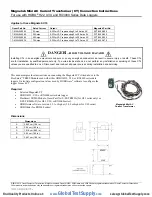
ENGLISH - 7/8
Input
The module accepts input from a PT100 (EN 60 751) or NI100 temperature probe with
connection by 2, 3 or 4 wires.
The use of shield cables is recommended for the electronic connections.
2-wire connection
This is the connection to be used for short distances ( < 10 m) between module and probe,
bearing in mind that it adds an error (which may be removed by sofware programming)
equivalent to the resistance contributed by the connection cables to the measurement.
DIP-switch SW1-1 set in ON Position (2 / 4 wires) or all DIP-switches in OFF position
(configuration from memory: module programmed by PC for 2 wires connection).
With bridges between Terminals 1 and 2 and Terminals 3 and 4.
3-wire connection
This is the connection to be used for media-long distances ( > 10 m ) between module and
probe. The instrument performs compensation for the resistance of the connection cables.
In order for compensation to be correct, it is necessary that the resistance values of each
conductors be the same because in order to perform compensation the instrument
measures the resistance of only one conductor and assumes the resistance of the others
conductors to be exactly the same.
DIP-switch SW1-1 set in OFF Position (3 wires) or all DIP-switches in OFF position
(configuration from memory: module programmed by PC for 3 wires connection).
With bridge between Terminals 3 and 4.
4-wire connection
This connection to be used for media-long distances ( > 10 m ) between module and probe.
Provides the maximum precision because the instrument measure the resistance of the
sensor independently of the resistance of the connection cables
.
DIP-switch SW1-1 set in ON Position (2 / 4 wires) or all DIP-switches in OFF position
(configuration from memory: module programmed by PC for 2 wires connection).
1
5
6
7
8
2
3
4
OUTPUT
INPUT
RTD 4 wires
RTD 3 wires
RTD 2 wires
MI00124 -E
2
1
2
3
4
1
2
3
4
1
2
3
4
J
J
J


























